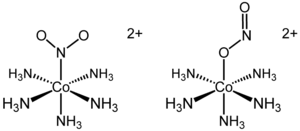Linkage isomerism
Linkage isomerism is the existence of coordination compounds that have the same composition differing with the connectivity of the metal to a ligand.
Typical ligands that give rise to linkage isomers are:
- thiocyanate, SCN− – isothiocyanate, NCS−
- selenocyanate, SeCN− – isoselenocyanate, NCSe−
- nitrite, NO2−
- sulfite, SO32−
Examples of linkage isomers are violet-colored [(NH3)5Co-SCN]2+ and orange-colored [(NH3)5Co-NCS]2+. The isomerization of the S-bonded isomer to the N-bonded isomer occurs intramolecularly.[1] In the complex, dichlorotetrakis(dimethyl sulfoxide)ruthenium(II), linkage isomerism of dimethyl sulfoxide ligands can be observed in the NMR spectrum due to the effect of S vs. O bonding on the methyl groups of DMSO. The proper notation for linkage isomerism is the kappa notation where the atom directly bonding to the metal is proceeded by the lowercase Greek letter kappa; κ. For example, NO2− is represented as nitrito-κ-N and nitrito-κ-O, replacing the old system of trivial names such as nitro and nitroso.[2]
History
The first reported example of linkage isomerism had the formula [Co(NH3)5(NO2)]Cl2. The cationic cobalt complex exists in two separable linkage isomers. In the yellow-coloured isomer, the nitro ligand is bound through nitrogen. In the red linkage isomer, the nitrito is bound through one oxygen atom. The O-bonded isomer is often written as [Co(NH3)5(ONO)]2+. Although the existence of the isomers had been known since the late 1800s, only in 1907 was the structural difference explained.[3] It was later shown that the red isomer converted to the yellow isomer upon UV-irradiation. In this particular example, the formation of the nitro isomer (Co-NO2) from the nitrito isomer (Co-ONO) occurs by an intramolecular rearrangement.[4]

References
- Buckingham, D. A.; Creaser, I. I.; Sargeson, A. M. (1970). "Mechanism of Base Hydrolysis for CoIII(NH3)5X2+ Ions. Hydrolysis and Rearrangement for the Sulfur-Bonded Co(NH3)5SCN2+ Ion". Inorg. Chem. 9 (3): 655–661. doi:10.1021/ic50085a044.<
- IUPAC. Compendium of Chemical Terminology, 2nd ed. (the "Gold Book"). Compiled by A. D. McNaught and A. Wilkinson. Blackwell Scientific Publications, Oxford (1997). XML on-line corrected version: http://goldbook.iupac.org (2006-) created by M. Nic, J. Jirat, B. Kosata; updates compiled by A. Jenkins. ISBN 0-9678550-9-8.
- Werner, A. (1907). "Über strukturisomere Salze der Rhodanwasserstoffsäure und der salpetrigen Säure". Ber. 40 (1): 765–788. doi:10.1002/cber.190704001117.
- Basolo, Fred; Hammaker, G.S (1 February 1962). "Synthesis and Isomerization of Nitritopentammine Complexes of Rhodium(III), Iridium(III), and Platinum(IV)". Inorganic Chemistry. 1 (1): 1–5. doi:10.1021/ic50001a001.